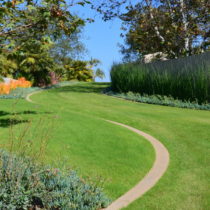Landscape Architecture for Landscape Architects › Forums › GENERAL DISCUSSION › Biobarrier – trifluralin
- This topic has 1 reply, 4 voices, and was last updated 13 years, 4 months ago by
 toby.
toby.
-
AuthorPosts
-
July 10, 2012 at 10:03 pm #157052
Gabe Ross
ParticipantWith a client looking for minimal long term maintenance on several gravel walkways and courtyard areas I have been considering proposing the Biobarrier product – as much as I dislike installing more persistant chemicals into the ground this maybe the lesser evil vs over enthuiastic herbicide use over the expected 15 year life of the biobarrer.
Has anyone tried this product http://www.biobarrier.com and if so did it prove successful?
July 11, 2012 at 12:28 am #157055 tobyParticipant
tobyParticipantBiobarrier will keep the roots of larger plants from intruding an adjacent space. I don’t know this will work how you envision.
Maintenance is something that everybody must accept.
Weeds grow where ever they can put a root down: cracks in concrete, asphalt, between brick, gravel, dg, etc. I’ve seen tree seeds sprout in roof gutters. I’ve seen Ficus nitida sprout from between a freeway bridge and an abutment wall. All a seed need is the right environment – a little bit of moisture.
There was a question from Alan Ray, RLA just a few weeks ago on this forum about a client that thought otherwise; the client threatened to litigate over the matter.
Tell the client to drink a glass of wine while they patrol the walkway with a flathead screwdriver to pry weeds out by the root. Before they know it, the task will be over, and they’ll be better off for it.
July 11, 2012 at 10:40 am #157054mark foster
ParticipantWeed barriers prevent root penetration, but the problem which develops (over time) is on top. Sediment (air or water borne) will settle in the gravel and produce a medium for shallow rooted plants–especially when adequate water is present. Finer weed cloths will also tend to clog with the sediment and make the situation worse.
The best thing to do is provide really good drainage below the barrier/gravel layer, starving the plants on top–such as a sub-layer of clean crushed stone, draining out.
A time release herbicide (or this product) could also be used, but I would consider it another layer of defense and not the primary one.
July 12, 2012 at 6:25 pm #157053 Matt KocianParticipant
Matt KocianParticipantWith considerations on the design profile and depth of aggregate, BioBarrier is a solution for this application. It is used as a root (vertical), pipe wrapping (surround), and weed barrier (horizontal) by stopping root intrusion by inhibiting cell division at the root tip or seed in the application types. Although it does utilize an above average 4oz geotextile (2-3 oz is your typical landscape cloth), it is more than just a weed cloth and performs very differently than typical landscape fabric because of its design incorporating both physical and chemical barriers. With reference to your concerns about treflan’s (trifluralin) persistence, it is a non-systemic, non-mobile, non-persistent chemical with the lowest possible EPA toxicity rating of a registered chemical. We chose this specifically for these attributes to mitigate risks while eliminating the need for unwanted surface applications that result in a variety of issues (untrained applicators, overapplication, surface runoff, improper chemical use, etc.). Treflan degrades rapidly after release (typically about 2-4 months when this close to surface), which is the reason for the injected nodule, slow-release design. The chemical is released out of the HDPE nodules at a controlled rate over time to continually maintain a vapor barrier of treflan that stops the germination of seed or persistence of seed roots in the profile, not just at the fabric barrier. A seed may start germination in the gravel, but as soon as the weed tries to expand its root system, it is stunted by the inability of cell division to continue. Because it is not absorbed by the plant, it does not affect adjacent ‘wanted’ vegetation. You are using BioBarrier creatively to orchestrate where you want growth to happen. The previous posts bring up valid issues, but they are addressed with proper profile design. An old, but informative video provides a good overview at: http://vimeo.com/11174004 or search for BioBarrier video on google. BioBarrier has over 35 years of successful documented applications, and the product warranty provides telling evidence of its long-term performance. If you would like assistance in designing the gravel walk, my contact details are on http://www.biobarrier.com.
-
AuthorPosts
- You must be logged in to reply to this topic.


